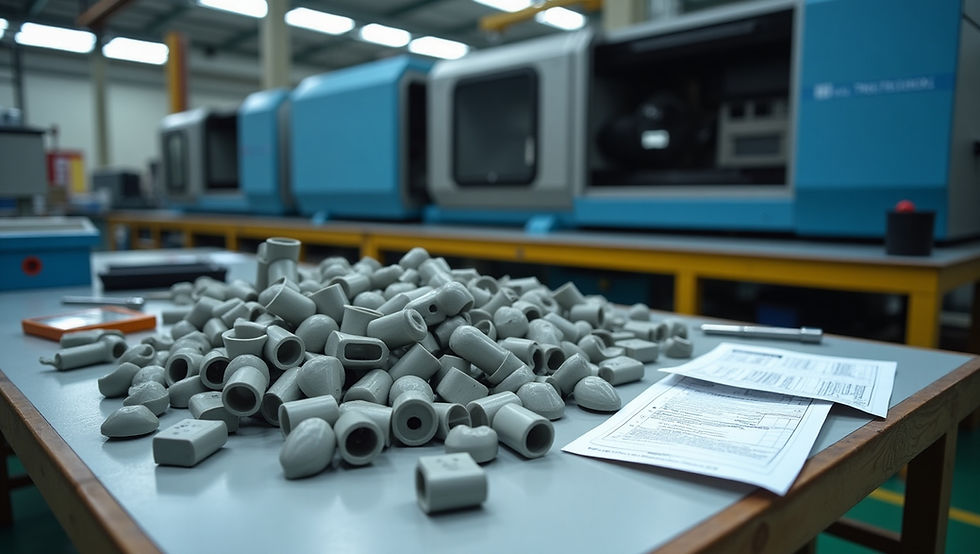Insert Molding vs. Overmolding: Which One is Right for Your Product?
- Shubh Poojara
- Feb 12
- 4 min read

Introduction: The Power of Multi-Material Injection Molding
Plastic injection molding is an incredible manufacturing process that allows product developers to create high-quality, durable, and functional components. But what if a product requires the combination of multiple materials? That’s where Insert Molding and Overmolding come into play.
These two techniques might seem similar, but they serve different purposes and require distinct production methods. Understanding their differences is crucial for making the right choice for your project.
Let’s dive into the details of Insert Molding and Overmolding, their advantages, limitations, and best-use cases.
But first, if you want to know what is injection molding in detail, read this before you go further.
What is Insert Molding?
Insert molding involves placing a pre-formed component (an insert) inside an injection molding tool. Thermoplastic resin is then injected around it, securing the insert permanently in place.

How It Works:
The insert (usually metal or plastic) is placed inside the mold on a holding pin or fixture.
The mold closes, and thermoplastic resin is injected around the insert.
The finished part is ejected with the insert firmly encapsulated.
Common Applications:
Threaded Fittings (Nutserts) – Eliminates the need for drilling and tapping.
Electronic Components – Encapsulation of electrical contacts.
Thin-Walled Cases – Adds strength where threading wouldn’t be possible.
Advantages of Insert Molding:
✅ Eliminates extra drilling and tapping, reducing assembly time.
✅ Can be used with conventional injection molding machines (no extra equipment needed).
✅ Allows for strong, permanent bonding between metal and plastic components.
Drawbacks of Insert Molding:
❌ If inserts are hand-loaded, it slows production and increases labor costs.
❌ If high holding strength is needed, additional design features may be required to lock the insert in place.
❌ Potential for cracks around the insert due to material shrinkage (especially in polycarbonate plastics).
When to Use Insert Molding:
Insert molding is ideal for low to mid-volume production (up to 20,000-50,000 units per year). For higher volumes, automation with robotic end-of-arm tooling is recommended.
Are you confused about selecting the appropriate manufacturing process? Read this to know about various plastic manufacturing processes.
What is Overmolding?
Overmolding, also called two-shot molding, 2K molding, or multiple material molding, is a process where a second material (typically rubber or elastomer) is molded over a rigid plastic substrate.
How It Works:
A rigid substrate is first molded and retained in the mold.
The mold shifts or rotates to a second cavity where a softer material (e.g., TPU, TPE, or silicone) is injected over the substrate.
The final product is ejected with a strong chemical or mechanical bond between the two materials.
Common Applications:
Toothbrush Handles – Soft rubber grip over a rigid base.
Power Tools & Utensils – Non-slip, comfortable handling.
Sealed Enclosures – Waterproofing and electrical insulation.
Advantages of Overmolding:
✅ Enhances grip and ergonomics with a soft, comfortable feel.
✅ Can be used for branding by incorporating logos or unique textures.
✅ Provides electrical and thermal insulation.
✅ Ensures air- and watertight seals for protective casings.
Drawbacks of Overmolding:
❌ Requires specialized dual-barrel injection molding machines or piggyback auxiliary systems.
❌ More complex mold design increases upfront tooling costs.
❌ Some material combinations (e.g., Nylon, PEEK, ABS) require special surface treatments for proper bonding.
Overmolding Production Techniques:
There are two primary automatic overmolding methods:
Shuttle Molding – The core side of the mold moves between two different cavities.
Carousel Molding – The mold rotates in a multi-station system for sequential processing.
For low-volume production, overmolding is sometimes done using two separate molds with manual transfer of the substrate.
Insert Molding vs. Overmolding: Key Differences
Feature | Insert Molding | Overmolding |
Process | Inserts placed in mold before injection | A second material is molded over an existing substrate |
Materials Used | Metal or plastic inserts | Thermoplastics, elastomers (TPE, TPU, Silicone) |
Bond Strength | Mechanical retention | Strong chemical and mechanical bond |
Equipment Needed | Standard injection molding machine | Specialized two-shot injection molding machine |
Common Uses | Threaded inserts, electronic components | Soft grips, waterproof seals, branding |
Cost | Lower for small production runs | Higher due to complex tooling |
Production Volume | Cost-effective for low-to-mid volumes | Best for high-volume automated production |
Choosing the Right Process for Your Project
So, which one is right for your product?
If you need to integrate metal or plastic components into a plastic housing, Insert Molding is the way to go.
If you want a soft-touch feel, added grip, or waterproofing, Overmolding is the best choice.
For high-volume production, Overmolding with automated two-shot molding is more efficient.
For low-volume runs, Insert Molding is more cost-effective unless overmolding can be done with manual transfer.
💡 Pro Tip: Always consult your manufacturing partner early in the design phase to optimize material selection, tooling, and production efficiency.
Conclusion: The Power of Smart Injection Molding Choices
Insert molding and overmolding are powerful manufacturing techniques that enhance product durability, aesthetics, and functionality. Choosing the right process can save costs, improve performance, and optimize production efficiency.
Understanding your product’s needs, production volume, and budget will help you determine the best molding method for your application. Whichever you choose, working closely with an experienced manufacturer is key to achieving the best results.
Got questions about injection molding? Drop us a comment below, and let’s talk molding magic! 🔧✨
Do you want to get an instant quote for your project? Click here and get 100% end-to-end assistance for your projects.





Very useful for Injection Molding